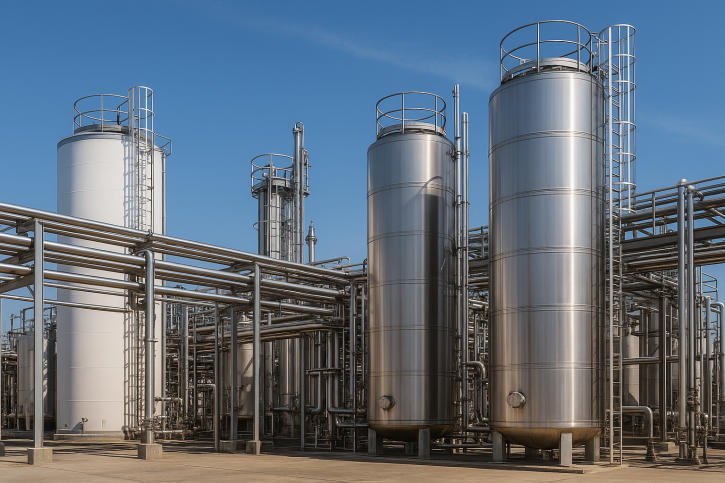Feedstocks for Biodiesel Production: Waste Oils, Fats & Emerging Sources
The success of biodiesel as a renewable energy solution depends heavily on its biodiesel feedstocks. While the production process—based on transesterification—remains consistent, the choice of raw materials dramatically impacts cost, efficiency, emissions, and sustainability. In today’s rapidly evolving energy landscape, feedstock flexibility is one of the main drivers shaping competitiveness and scalability in sustainable biofuels.
This article explores the range of feedstocks available for biodiesel, from conventional vegetable oils to animal fats, used cooking oil (UCO), and advanced emerging sources such as algae and lignocellulosic residues. It also examines the economic and regulatory pressures influencing feedstock selection in 2025 and beyond.
Why Feedstocks Matter in Biodiesel Production
Feedstocks represent up to 70–80% of the total production cost of biodiesel. This makes the choice of raw material a strategic decision not only for producers but also for policymakers and end users. Different feedstocks vary in terms of availability, price, energy content, and greenhouse gas (GHG) savings. Therefore, choosing the right feedstock mix is essential for achieving both profitability and sustainability goals.
Moreover, regulations such as the European Union Renewable Energy Directive II (RED II) and the U.S. Renewable Fuel Standard (RFS) impose strict sustainability criteria, pushing producers toward waste-based and advanced feedstocks. As the biofuels industry enters 2025, diversification away from food-based oils is becoming the norm rather than the exception.
Conventional Vegetable Oils
For decades, the primary biodiesel feedstocks have been vegetable oils. These include soybean oil, rapeseed (canola) oil, sunflower oil, and palm oil. Each has unique properties influencing biodiesel quality and performance.
Soybean Oil
Soybean oil is the most common biodiesel feedstock in the United States and Brazil. It offers high oil content, reliable supply chains, and established agricultural infrastructure. However, soybean-based biodiesel typically delivers 50–60% GHG savings, less than waste-based alternatives. Land-use change also raises sustainability concerns.
Rapeseed Oil (Canola)
Rapeseed oil dominates the European biodiesel market. With favorable cold flow properties, rapeseed-based biodiesel performs better in colder climates compared to soy or palm. Yet, like soybean, it competes with food uses and raises land-use efficiency debates.
Sunflower Oil
Sunflower oil provides high-quality biodiesel but at a higher cost. It is used primarily in regions where sunflower is an abundant crop. The fuel has good oxidative stability but limited scalability due to smaller global supply.
Palm Oil
Palm oil is the cheapest vegetable oil feedstock, widely used in Asia. However, its association with deforestation and biodiversity loss makes it controversial. Under RED II, the EU is phasing out palm oil-based biodiesel by 2030.
Animal Fats
Animal fats such as tallow, lard, and poultry fat are cost-effective biodiesel feedstocks. They are by-products of the meat industry, turning waste into valuable energy. Key benefits include:
- Lower cost than vegetable oils.
- High energy density and favorable GHG savings (60–70%).
- Utilization of waste streams, reducing environmental impact.
Challenges include feedstock variability, impurities, and limited supply. Proper pretreatment is required to remove free fatty acids (FFA) and contaminants before transesterification.
Used Cooking Oil (UCO)
Used cooking oil (UCO) is among the most sustainable and politically favored biodiesel feedstocks. It provides up to 85% GHG savings compared to fossil diesel, making it highly attractive under regulatory schemes such as the EU RED II and California’s Low Carbon Fuel Standard (LCFS).
Key challenges include collection and logistics. UCO is generated in small volumes across households, restaurants, and food industries, requiring robust collection networks. Despite this, UCO-based biodiesel is scaling rapidly in Europe and Asia.
Emerging Feedstocks
As demand for sustainable biodiesel feedstocks grows, attention is shifting to advanced options that do not compete with food supply.
Algae
Algae-based biofuels have long been viewed as a promising solution due to their high oil yield per hectare, rapid growth, and ability to thrive on non-arable land. Algae also absorb CO₂, contributing to negative emissions. However, commercial-scale production remains limited due to high costs and technological hurdles in harvesting and oil extraction.
Lignocellulosic Residues
Lignocellulosic feedstocks such as crop residues, forestry waste, and municipal solid waste represent another frontier. These materials are abundant, cheap, and sustainable. Technologies such as pyrolysis and gasification could convert these residues into biodiesel precursors, though large-scale deployment is still in development.
Industrial By-Products
By-products such as tall oil from the pulp and paper industry and fatty acid distillates from refining processes are gaining traction. These sources improve circularity and reduce reliance on virgin feedstocks.
Comparative Analysis of Feedstocks
| Feedstock | Cost | GHG Savings | Scalability | Challenges |
|---|---|---|---|---|
| Soybean Oil | Moderate | 50–60% | High | Land-use, food competition |
| Rapeseed Oil | High | 55–65% | Moderate | Cost, food competition |
| Palm Oil | Low | 40–50% | High | Deforestation concerns |
| Animal Fats | Low | 60–70% | Moderate | Impurities, limited supply |
| Used Cooking Oil | Low–Moderate | 80–85% | Growing | Collection logistics |
| Algae | High | 90%+ | Low (pilot stage) | Costs, harvesting technology |
Regulatory and Market Dynamics
Feedstock selection is not just a technical choice; it is shaped by policy, subsidies, and consumer demand. The EU’s RED II sets stricter limits on crop-based biofuels, while offering incentives for waste-based and advanced feedstocks. In the U.S., the RFS and LCFS create financial advantages for low-carbon feedstocks such as UCO and animal fats.
By 2025, producers must adapt to tighter sustainability criteria, traceability requirements, and growing pressure from consumers demanding transparency in the fuel supply chain.
Conclusion
The evolution of biodiesel feedstocks reflects the industry’s broader transition toward sustainability and efficiency. From conventional vegetable oils to waste-based and advanced options, the feedstock landscape is diversifying rapidly. The future of biodiesel lies in balancing cost, sustainability, and scalability through innovative feedstock strategies.
For a full overview of the biodiesel production process, technologies, and market outlook, see our detailed Pillar on Biodiesel Production.
Want to explore the complete biodiesel production journey, from feedstocks to refining and market outlook?

